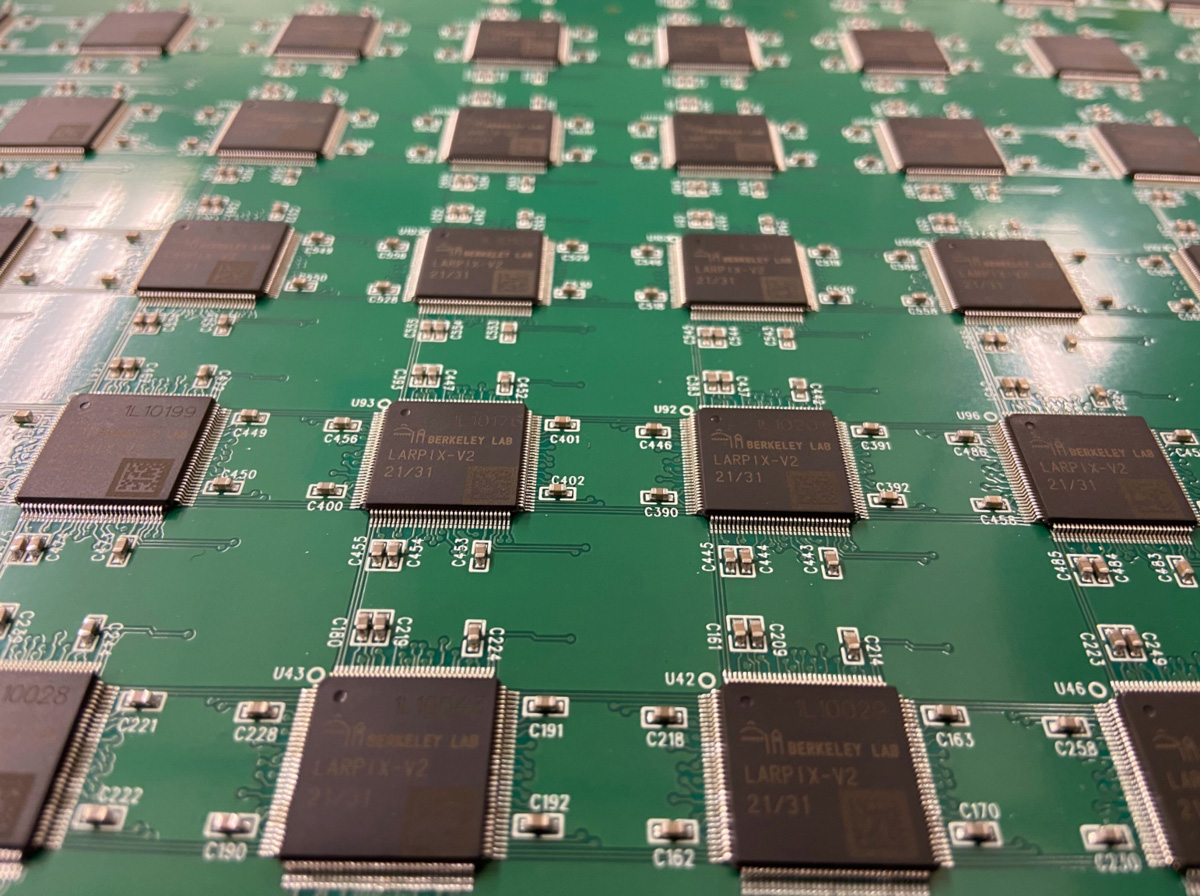Seven innovative technologies from the U.S. Department of Energy’s (DOE) Lawrence Berkeley National Laboratory (Berkeley Lab) have been honored with a 2022 R&D 100 Award. The award, presented by R&D Magazine and selected by an independent panel of judges, recognizes the year’s 100 most innovative and disruptive technology products from industry, academia, and government-sponsored research.
Berkeley Lab’s winning technologies diagnose disease, generate green hydrogen, improve battery performance and recyclability, and increase energy efficiency. The winning teams will be celebrated at the R&D 100 gala banquet in San Diego on November 17.
Below are descriptions of the technologies:
Spectral Phenotyping with MirroRx
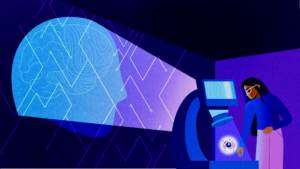
(Credit: Jenny Nuss)
Diseases such as Alzheimer’s are difficult to diagnose before symptoms occur, while others like aggressive cancers need to be detected early for improved survival rates. Berkeley Lab scientists have developed MirroRx, a biomarker technology that accurately predicts disease status. The disease phenotype is analyzed by measuring how the patient’s endogenous molecules vibrate upon exposure to infrared light. The difference in the vibrational profile of disease and control samples is so visible that the spectral process is like “cellular fingerprinting.” Early tests with presymptomatic Alzheimer’s patients accurately predicted those who eventually developed the disease.
The development team led by Cynthia McMurray includes Edward Barnard, Ben Brown, Dhruba Ghosh, Lila Lovergne, and Aris Polyzos.
Hydra I/O: A System for Highly Resilient Inter-chip Communications

Failed ASICs in this tile can be routed around automatically with the Hydra I/O system. (Credit: Brooke Russell)
In traditional systems of arrayed Application Specific Integrated Circuits (ASICs), chip-to-chip data paths are typically hard-wired, or use shared data busses. This approach risks the reliability of the entire system when individual ASICs fail, particularly in situations where repair or replacement of individual ASICs is inconvenient or impossible. Hydra I/O is a system to create ad-hoc, software-defined networks of ASICs that can be automatically reconfigured to route around individual failed ASICs without compromising the overall network. Hydra I/O enables enhanced system reliability in extreme environments for space, underwater, defense, communication, and scientific applications. For example, a 1,600 ASIC Hydra I/O system was recently successfully operated in a difficult-to-access particle physics detector at -200 degrees Celsius.
Investigators: Daniel Dwyer (PI), Carl Grace (PI), Dario Gnani, Armin Karcher, Peter Madigan, and Brooke Russell.
Solar Fuel Generator Including a Catalytic Mesh
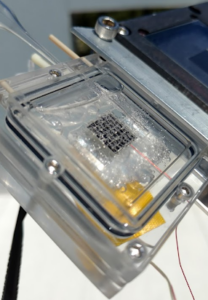
Solar fuel generator device. (Credit: Karl Walczak)
Green hydrogen is a clean, renewable alternative to hydrogen that is today produced from fossil fuel sources. This invention generates limitless quantities of green hydrogen, using only sunlight and water and producing only oxygen as a byproduct. Its standalone, modular nature promises to bring the benefits of clean hydrogen everywhere, even where there is no electrical grid or large scale manufacturing infrastructure as is required by current electrolyzer technology.
Investigators: Jeff Beeman (Berkeley Lab, retired), Frances Houle (Berkeley Lab), David Larson (Twelve), Gideon Segev (Tel Aviv University), and Ian Sharp (Technical University of Munich), and Karl Walczak (Sandia National Laboratories).
Quick-Release™ Binder for Recyclable Batteries
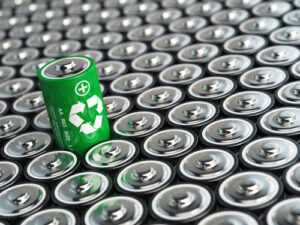
(Credit: Maxx-Studio)
The Quick-ReleaseTM Binder solves a major challenge of materials recovery for Li-ion battery direct recycling. The current recycling process, which includes shredding, grinding, and pyrolysis of the materials, is highly energy intensive and has a large environmental footprint. The Quick-Release Binder eliminates these processes–as well as the production of toxic gases–by using water processes for manufacturing and recycling. All the battery components simply dissociate in pH adjusted water and are easily recovered and reprocessed. As a low-cost, nontoxic, and effective product, the Quick-Release binder represents a major technological advancement, and it facilitates the use and expansion of green energy storage, supporting international efforts to create a circular economy.
Investigators: Gao Liu (PI), Robert Kostecki (PI), and Steve Sloop (PI, OnTo Technology), Chen Fang, Xin He, Zhimeng Liu, and Yangzhi Zhao.
Stable and High-Performing Single-Crystal LiNixMnyCo1-x-yO2 Cathode Materials (SC-NMC)
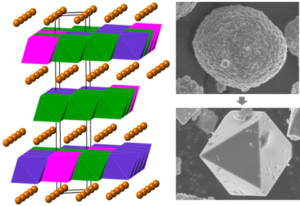
SC-NMC (bottom right) in comparison to commercial polycrystalline particles (top right). (Credit: Guoying Chen and Yanying Lu)
Next-generation lithium-ion batteries need to have higher energy density and power density at a lower cost, with better safety and longer lifespans. Berkeley Lab scientists have developed a method of producing Single-Crystal NMC Cathode Materials (SC-NMC) that eliminates the fracturing and reduces the side reactions on the particle surface. Cathodes using the resulting product remain mechanically intact. The method’s processes can be adopted into existing production lines, and SC-NMCs made with this method deliver significantly improved performance and stability compared to commercial polycrystalline materials.
Investigators: Guoying Chen (PI) and Yanying Lu.
City Buildings, Energy, and Sustainability (CityBES) Web Tool for Climate Change Strategies
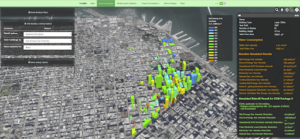
CityBES showing a group of commercial buildings in San Francisco with energy retrofit modeling results.
Buildings generate 39% of global CO2emissions, but evaluating and prioritizing cost-effective technical solutions for individual buildings at city scale poses a significant challenge for city stakeholders. CityBES is a free, powerful modeling and analysis tool that enables quick and quantitative assessments of actionable recommendations for decarbonizing buildings and improving their thermal resilience against extreme weather at the urban scale. CityBES builds upon open city datasets, international data standards, the powerful EnergyPlus simulation engine, a library of mitigation and adaptation measures, and 3D-GIS visualization to inform decision making on city buildings, energy, and sustainability.
Investigators: Tianzhen Hong (PI), Mary Ann Piette (PI), Max Wei (PI), Wanni Zhang, Yujie Xu, Han Li, Kaiyu Sun, and former Berkeley Lab researchers Yixing Chen and Xuan Luo.
The SEED Platform: Decarbonizing Cities Through Robust Data Management

(Credit: Sean Pollock)
Managing building performance data (such as required by a benchmarking ordinance) can be costly and time consuming for states, local governments and other organizations. A Berkeley Lab team, in collaboration with the National Renewable Energy Laboratory, has developed building energy efficiency data management software called the Standard Energy Efficiency Data Platform (SEED). It is an open-source software application designed to manage building performance data; it helps users combine data from multiple sources, clean and validate it, and generate queries and reports.
Investigators: Paul Mathew, Robin Mitchell, and Nicholas Long (National Renewable Energy Laboratory)
For information about licensing the above technologies, contact [email protected].
# # #
Founded in 1931 on the belief that the biggest scientific challenges are best addressed by teams, Lawrence Berkeley National Laboratory and its scientists have been recognized with 14 Nobel Prizes. Today, Berkeley Lab researchers develop sustainable energy and environmental solutions, create useful new materials, advance the frontiers of computing, and probe the mysteries of life, matter, and the universe. Scientists from around the world rely on the Lab’s facilities for their own discovery science. Berkeley Lab is a multiprogram national laboratory, managed by the University of California for the U.S. Department of Energy’s Office of Science.
DOE’s Office of Science is the single largest supporter of basic research in the physical sciences in the United States, and is working to address some of the most pressing challenges of our time. For more information, please visit energy.gov/science.
